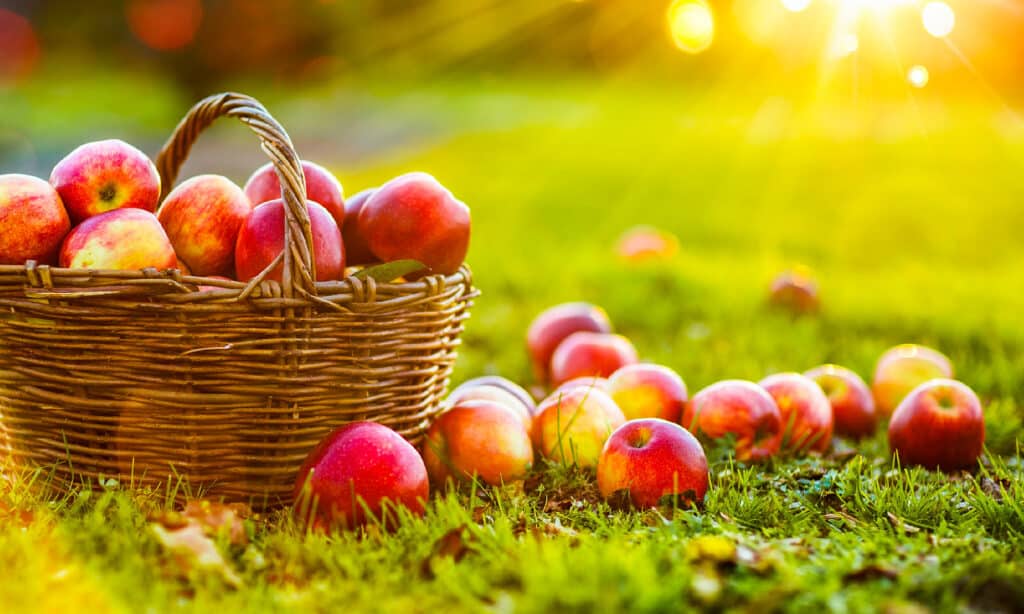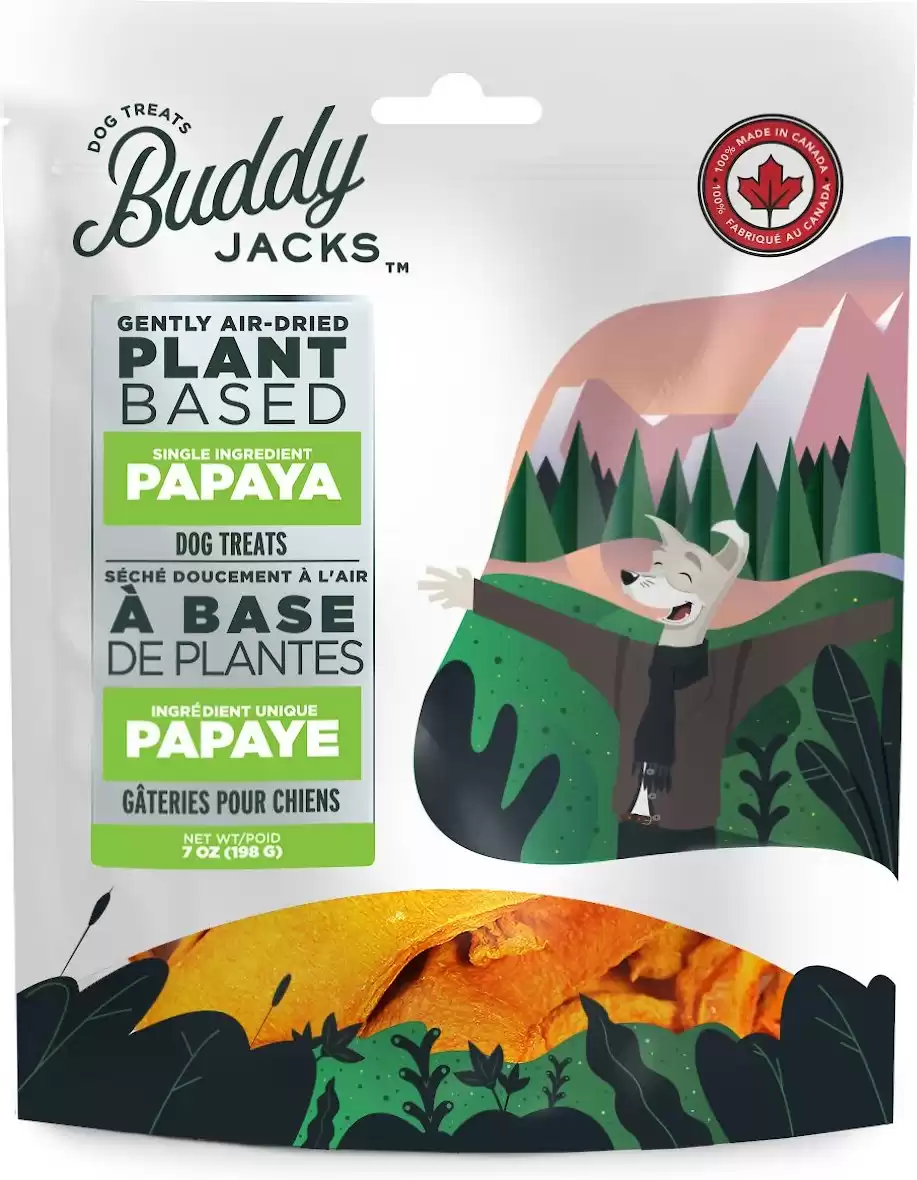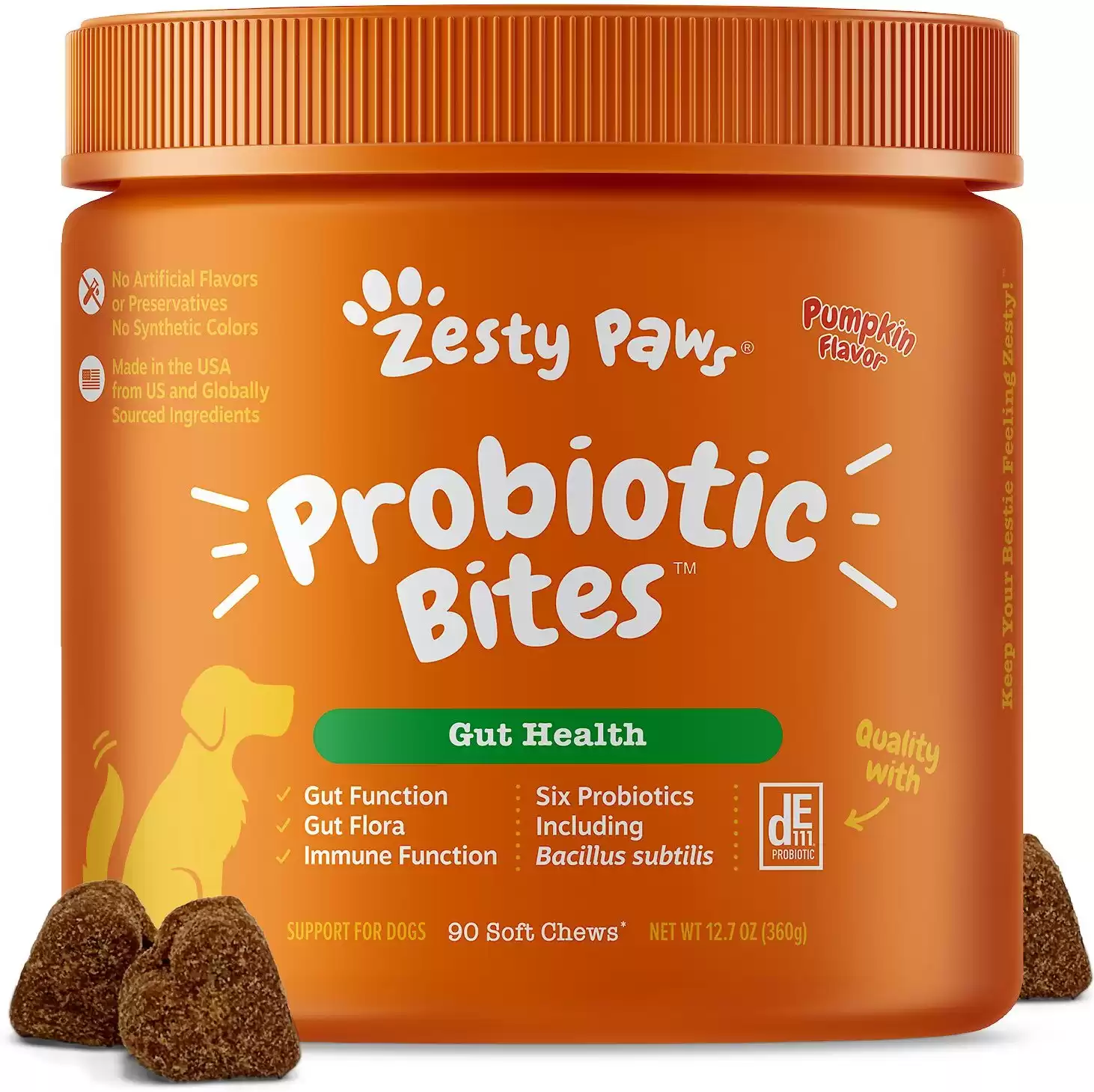Some dog owners share almost all their meals with their fur friends, and the pups seem to enjoy them. However, you should be choosy with the fruits you feed your pets, considering their breed and age before offering the first bite. And if you are used to sharing foods and fruits with your them, can your dog eat papaya?
Papaya is a tropical tree fruit also called papaw. It contains many minerals, vitamins, and antioxidants that are helpful to human beings and dogs. Therefore, you can feed your canine friend papaya but in moderation.
Too much papaya can cause gastrointestinal issues in your pup. Besides that, you need to ensure you give your dog the soft textured part only because it is easy to digest. The following are the health benefits and risks of giving papaya to your dog. You will also get suggestions on good and healthy fruits for your little canine friend.

Close up papaya with papaya leaf on wooden table background.
©iStock.com/nattaphol phromdecha
Can Dogs Eat Papaya?
Papaya is a soft, healthy, and delicious fruit for dogs, which many canines enjoy eating. Therefore, your pup will enjoy this snack. Besides being tasty, papaya is nutritious to the canines. It contains minerals and vitamins that help in boosting the dog’s health and keep his skin flawless.
Papaya is also a source of fiber that helps the dogs in digestion. Besides that, the fruit has digestive enzymes and a good water source.
However, dog owners should feed the pets a specific amount of papaya. Too much of the fruit can cause complications like a gastrointestinal blockage. Ensure that you ask your vet about the right amount of papaya to feed your dog.
The vets consider the dog’s breed, age, weight, and size to calculate the correct amount of a particular food. They also consider the pup’s health conditions. These factors are also essential when choosing what you feed your dog.
Giving the dog foods that are not compatible with their age, size, or weight, or those that are unsuitable for their breed can cause allergies, sensitivities, and other complications. Additionally, the wrong dog food can lead to diabetes and cancer for some dogs
- Air-dried to retain flavor and nutrients
- Vegan and free from preservatives, antibiotics, and other harmful addititives
- Made entirely from papaya
- Great for dogs that have sensitive stomachs
- Safe for dogs of all sizes
Parts of Papaya Not to Give Your Dog
Although papaya is a delicious fruit that benefits humans and dogs, you should be picky with the parts you are feeding your pup. The fruit has some hard-to-digest parts and other elements that contain toxic fluids and gases. So when feeding papaya to your dog, don’t give it these parts:
Papaya Skin
Some dog owners claim that the papaya skin is perfect for fiber, but it is hard for your dog to chew and digest. The skin can also cause choking to your canine. Worse still, it could get stuck in the dog’s digestive tract, causing an emergency visit to the vet. In this respect, your dog should not eat papaya.
Papaya’s skin also causes a gastrointestinal blockage to the dogs, which is uncomfortable and fatal. You will notice symptoms like body weakness, nausea, vomiting, and diarrhea if this happens. Call your pet clinic when you immediately notice any of these symptoms.

Papaya is safe for dogs as long as you follow certain feeding guidelines.
©New Africa/Shutterstock.com
Seeds
Many dog owners are too lazy to remove papaya seeds, but they pose a risk to your canine friend. This fruit’s seeds contain tiny amounts of cyanide, a toxic compound. Although there is no harm in eating a small quantity of the seeds, remove them anyway. It’s easier to keep your pup safe than dealing with an emergency visit to the vet.
Besides, the seeds are bitter, and when the dog chews them, they might not eat the healthy part of the papaya. However, humans can eat papaya seeds because they have health benefits.
Health Benefits of Papaya to the Dog
Once you remove the skin and the seeds, your dog will enjoy the soft flesh of the fruit. Besides being delicious, the fruit has many health benefits for your pup. Some of the most valuable nutrients in papaya are:
Vitamin A
Dog’s kibble contains vitamin A, but they can get more from papaya. Vitamin A in papaya is called beta-carotene, and it is converted in the liver. Surprisingly, the dog’s body can use papaya’s vitamin A as an antioxidant if it gets enough from the normal kibble.
Vitamin C
A strong immune system is built by vitamin C, and your pup can get this from the papaya fruit. Although some dog owners argue that they get better vitamin C for the dog from oranges, papaya contains more.
The vitamin also helps in preventing damage to your dog’s joints. However, don’t give the whole papaya at once to your dog. It will cause adverse effects like bloating and gastrointestinal problems.
Fiber
Fiber is an important compound found in most fruits, and it helps your pups with digestion. Also, the compound helps in maintaining normal bowel movements to prevent constipation. Papaya is also a perfect fruit for your dog because it helps support the gut microbiome.
But too much fiber for your dog makes it hard for the body to absorb minerals. A lot of fiber can also cause diarrhea and excessive flatulence. In addition, the dogs are carnivorous, so they need higher amounts of meat than plant materials.
- Soft chews in a base of pumpkin and papaya
- Includes six probiotics (live bacteria)
- Supports gut function
- Helps to prevent diarrhea, gas, and bloating
- Appropriate for dogs of all sizes
Magnesium
Like human beings, dogs need magnesium for muscle development and heart health. The mineral also helps with the functioning of the different body parts and the electrical signaling of the nervous system.
Potassium
One of the papaya’s dominant minerals is potassium, which helps nutrient absorption in your dog’s body. Potassium is also good for bones and muscle growth, and the mineral gives your canine friend energy to run and play around.
Papain
Papaya contains a plant-based enzyme called papain, which helps break down the proteins in other food for more energy. However, papain is heat-sensitive, so ensure you don’t expose the papaya to heat.
Lycopene
Lycopene is a rare-to-find compound in plants. It is an antioxidant and can be helpful for the heart, brain, eyes, and skin. Lycopene also slows down cancer cell growth and boosts your dog’s immunity.

Lima beans are only safe for your dog to eat when they are fed plain, uncanned, and in small amounts.
©AndrasKiss/Shutterstock.com
Risks of Feeding Papaya to Your Dog
Papaya is a healthy fruit for dogs that contains minerals and nutrients in abundance. However, the fruit can cause gastrointestinal complications with symptoms like diarrhea and vomiting when given in excess.
These symptoms cause dehydration in your dog, and you need to seek a vet’s advice immediately. When you start feeding papaya to the dog, start with small amounts. This helps you judge if your pet is allergic to the fruit or if they can comfortably eat it.
Stop feeding papaya to your canine if it shows allergic symptoms. Ensure to seek advice from your veterinary about the right amount of papaya to feed your pup, depending on their age, weight, and breed.
If you introduce papaya to the dog and there are no adverse reactions, continue giving it in measured amounts. Also, ensure you peel the papaya and remove the seeds because they negatively affect dogs.
Other Fruits Your Dog Can or Can’t Eat
While dogs benefit from fruits and vegetables, dog owners should be picky with the fruits to feed their pups. Some of the fruits to avoid are:
Avocado
Avocado has many health nutrients for humans, but it is not friendly to dogs. This fruit’s skin, pit, and leaves contain a toxic compound called persin. Unfortunately, the fruit’s fleshy inside also has little of this toxic element. Persin causes vomiting and diarrhea in the dogs, leading to dehydration.
Cherries
Cherries belong to the category of the fruits you should never give your dog to taste. The plant contains cyanide, a toxic compound that disrupts the transportation of cellular oxygen in dogs.
The compound makes it difficult for oxygen to get to the dog’s blood cells, which could be fatal. Ensure you phone your vet immediately after your pet gobbles down your cherries.
Safe Fruits to Give Your Dog
Blueberries
Your dog will benefit from eating berries because the fruit contains antioxidants. These prevent cell damage in your dog, leaving it with glowing and healthy skin. Berries also contain enough fiber to help the dog’s digestion but ensure you don’t give your pup too much of the fruit.
Apples
You probably like to have apple bites, and you can also let your canine friend have some. The fruit is valuable to them because it contains vitamin A and C. Besides, it is low in protein and fat, so you won’t worry about obesity and other overweight-related problems in your loyal friend.
However, ensure you peel the apple and remove the seeds before giving it to your dog. You can also freeze them and give them to your dog during summer. If you can’t get the fruit, buy apple-flavored dog treats. Your pup will love and enjoy them.

©iStock.com/Baks
Bananas
If your canine friend is watching you eat a banana with a tilted head and those spiking innocent eyes, you can let them have some. The fruit has low calories and contains potassium, vitamins, and fiber. However, bananas have high sugar, so you should moderately feed them to your dog. If you want to find out more, check this out!
Conclusion
Dogs digest foods differently than humans do, and eating the wrong foods can lead to long term health problems and in extreme cases, death. As omnivores, dogs have no real need for fruits or vegetables, but small amounts of fruits and vegetables make a healthy treat. Fresh and high quality dog foods pre-portion fresh vegetables in meals for their health benefits. Papaya is a healthy fruit treat for your pup because it is rich in minerals, nutrients, and vitamins. The fruit also aids with digestion, thanks to fiber. However, make sure you remove the seeds and the skin for your dog’s safety and consult your vet to get the right amount to feed your pet.
Up Next…
- The Best Limited Ingredient Dog Food (Good For Allergies) in 2022: If your pup has allergies, you need to check out our suggestions for the best dog foods for your special dog.
- The Best Dog Food for Shedding for 2022: You brush your dog every day – and he still sheds! Can a special food be the solution? Yes, it can!
- The Best Slow Eating Dog Bowls: Updated for 2022: Your dog’s tummy troubles may be caused by his eating too fast. Slow him down with one of these bowls designed to fix this common problem.
- Is Broccoli Safe For Dogs? How Much Can They Eat?: We explored the benefits of papaya – now, find out if broccoli is good for your pup!
The photo featured at the top of this post is © New Africa/Shutterstock.com
Ready to discover the top 10 cutest dog breeds in the entire world?
How about the fastest dogs, the largest dogs and those that are -- quite frankly -- just the kindest dogs on the planet? Each day, AZ Animals sends out lists just like this to our thousands of email subscribers. And the best part? It's FREE. Join today by entering your email below.
Thank you for reading! Have some feedback for us? Contact the AZ Animals editorial team.








